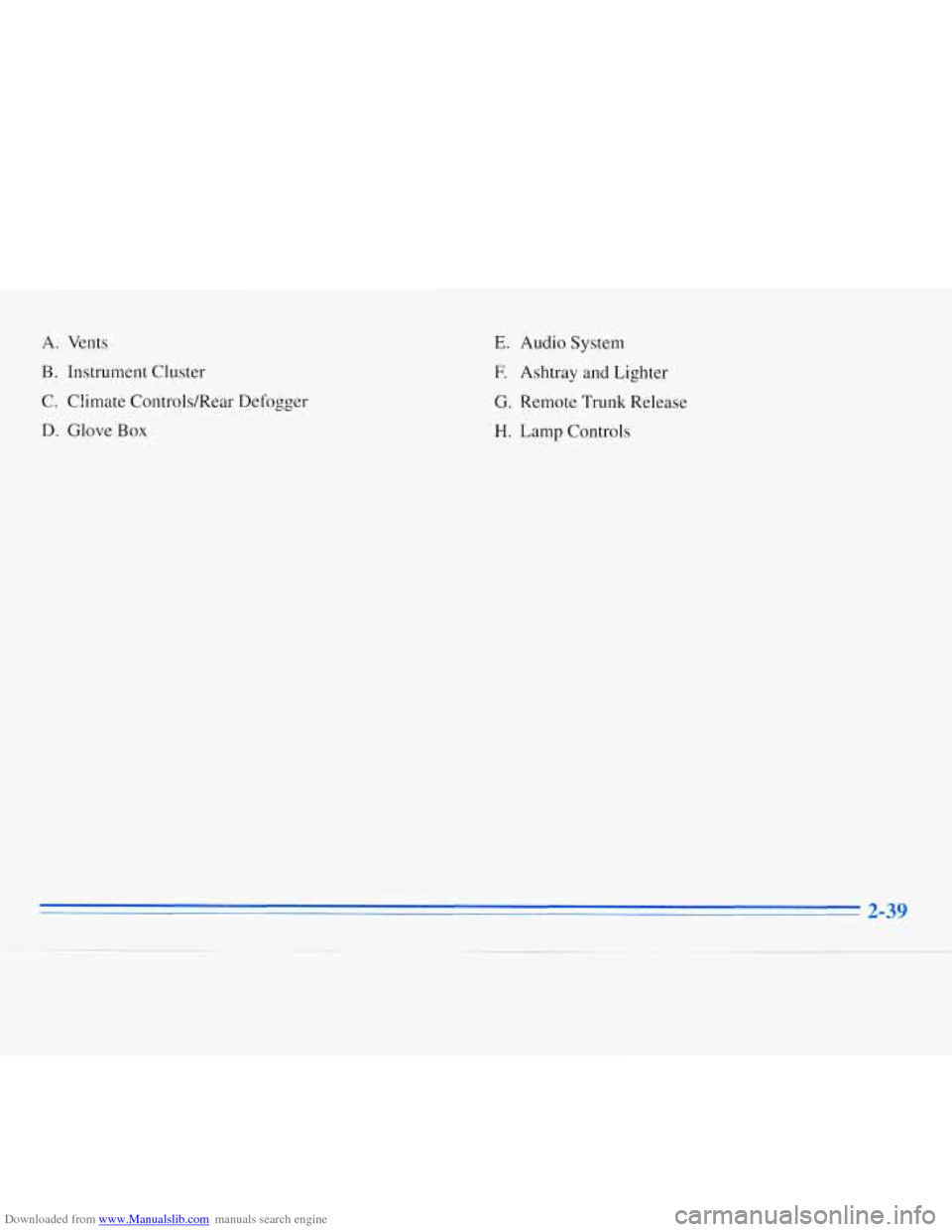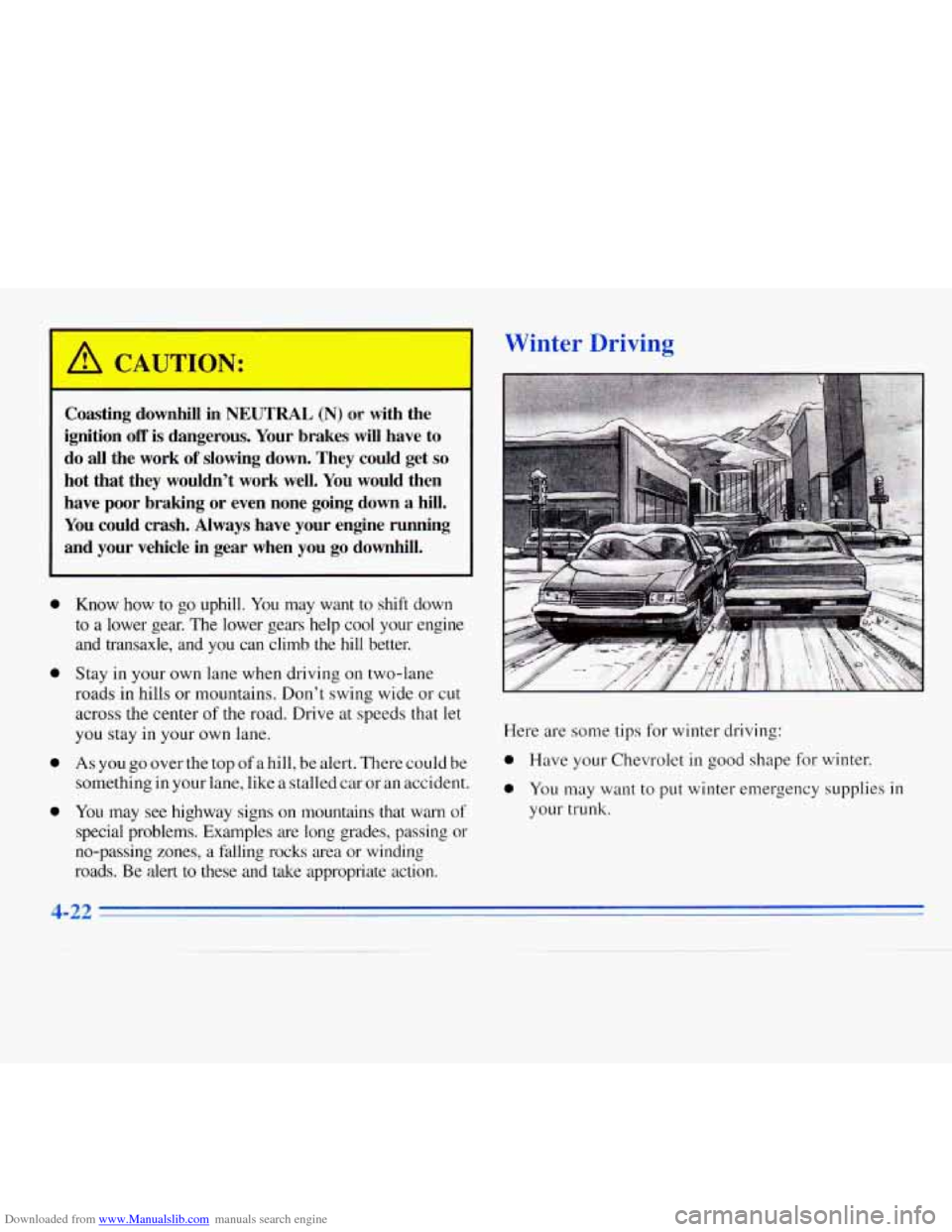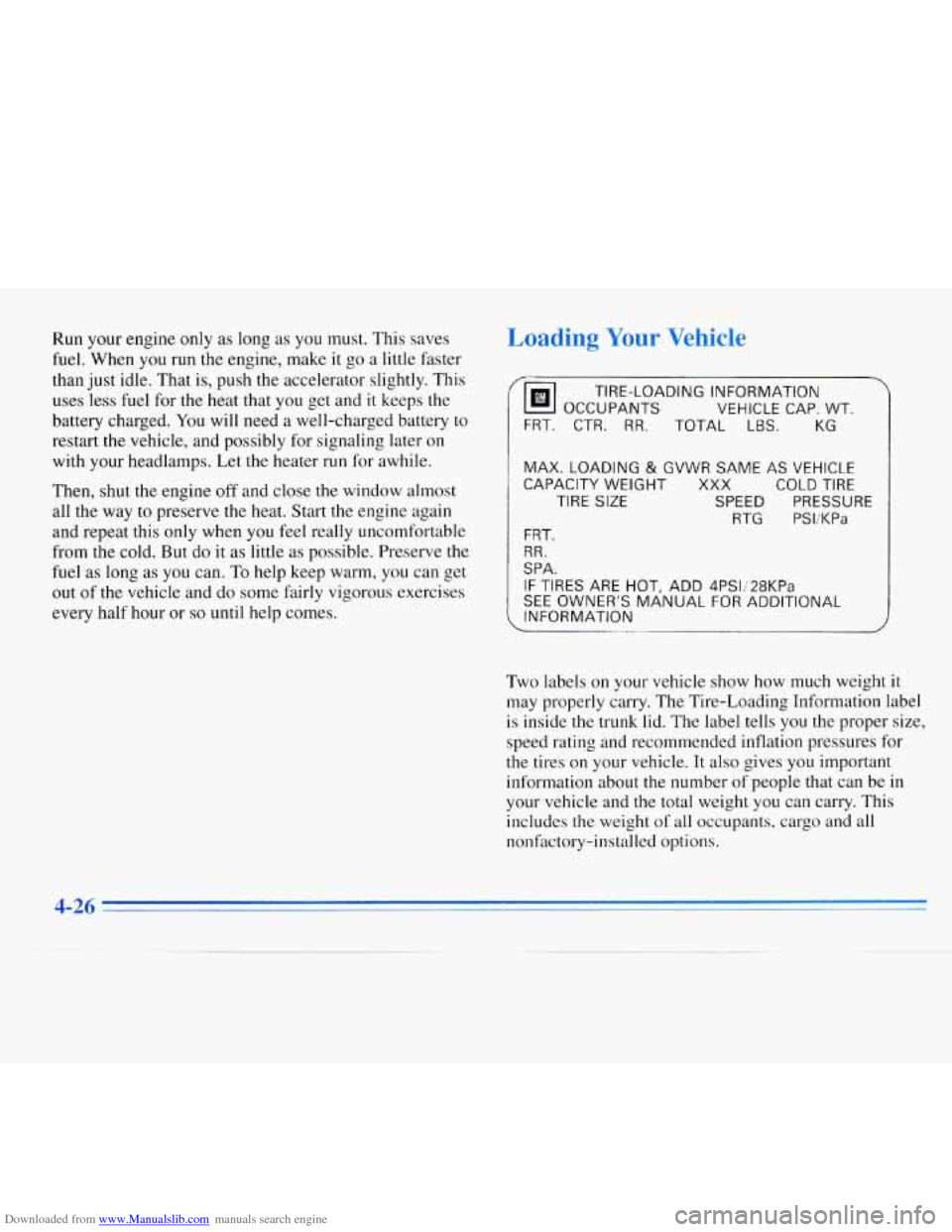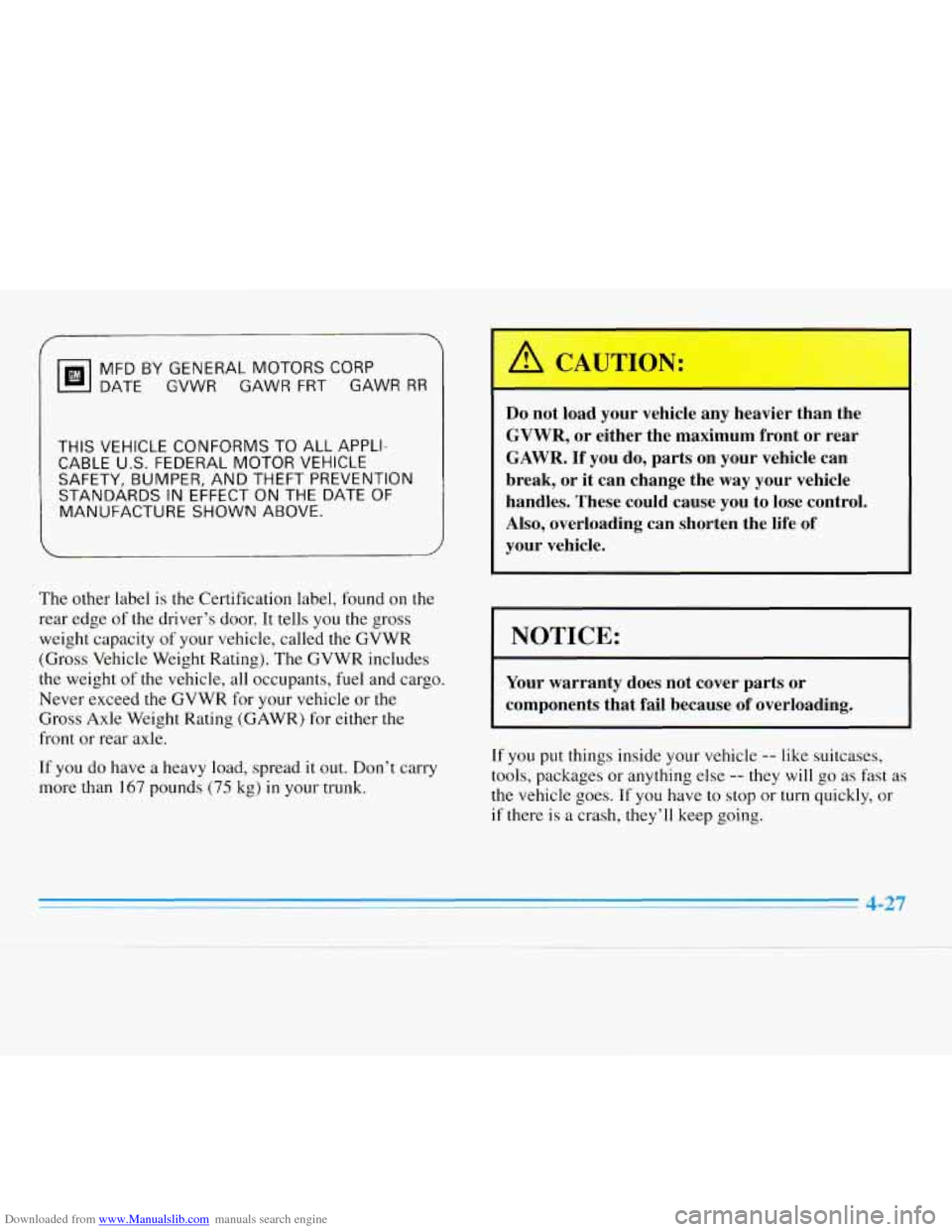1996 CHEVROLET MONTE CARLO trunk
[x] Cancel search: trunkPage 62 of 340

Downloaded from www.Manualslib.com manuals search engine IT your Chevrolet has this option, you can lock and
unlock your doors or unlock your trunk from up to
30 feet (9 m) away using the key chain transmitter
supplied with your vehicle.
Your Remote Lock Control transmitter operates on
a
radio frequency subject to Federal Communications
Commission (FCC) Rules.
This device complies with
Part 15 of the FCC Rules.
Operation is subject to the following two conditions:
(1) This device may not cause harmful interference, and
(2) This device must accept any interference received,
including interference that may cause undesired operation.
Should interference to this system occur, try this:
Check to determine if battery replacement is necessq.
See the instructions on battery replacement.
Check the distance. You may be too far from your
0 Check the location. Other vehicles or objects may be
See your Chevrolet dealer or a qualified technician
Changes or modifications to this system by other than an
authorized service facility could void authorization to
use this equipment.
vehicle.
This product has
a maximum range.
blocking the signal. for service. Press
UNLOCK once to unlock the driver’s door. Press
UNLOCK again within five seconds to unlock the
passenger’s door, too. The interior lamps will come on
(see “Sustained Interior Illumination” in the Index for
more details).
To lock both doors, press DOOR. To unlock the trunk,
press the trunk symbol on the transmitter. The trunk will
only unlock
if your transaxle is in PARK (P).
Page 64 of 340

Downloaded from www.Manualslib.com manuals search engine Trunk Trunk Lock
It can be dangerous to drive with the trunk lid
open because carbon monoxide (CO) gas can
come into your vehicle. You can't see or smell
CO. It can cause unconsciousness and even death.
If you must drive with the trunk lid open or if
electrical wiring
or other cable connections must
pass through the seal between the body and the
trunk lid:
~ 0 Make sure all windows are shut.
0 Turn the fan on your heating or cooling
system to its highest speed with the setting
on VENT. That will force outside air into
your vehicle. See "Comfort Controls'' in
the Index.
instrument panel, open them all the way.
If you have air outlets on or under the
See "Engine Exhaust" in the Index.
To unlock the trunk from
the outside, insert the door
key and turn it.
You can also
use the Remote Lock
Control transmitter,
if your
vehicle has this option.
2-6
Page 65 of 340

Downloaded from www.Manualslib.com manuals search engine Remote Trunk Release (Option)
Press the button under
the instrument panel
on
the driver’s side. Your
transaxle shift lever must
be in PARK
(P).
Remember that your trunk can be opened at any time
using this lock release. Be sure to lock your doors.
Theft
Vehicle theft is big business, especially in some cities.
Although your Chevrolet has a number
of theft-deterrent
features, we know that nothing we put on it can make
it
impossible to steal. However, there are ways you can help.
Key in the Ignition
If you leave your vehicle with the keys inside, it’s an
easy target for joy riders or professional thieves
-- so
don’t do it. When
you park your Chevrolet and open the driver’s door,
you’ll hear
a chime reminding you to remove your key
from the ignition and take it with you. Always do this.
Your steering wheel will be locked, and
so will your
ignition and transaxle. And remember to lock the doors.
Parking at Night
Park in a lighted spot, close all windows and lock your
vehicle. Remember
to keep your valuables out of sight.
Put them in a storage area, or take them with you.
Parking Lots
Tf you park in a lot where someone will be watching
your vehicle, it’s best
to lock it up and take your keys.
But what if
you have to leave your ignition key? What if
you have to leave something valuable in your vehicle?
0 Put your valuables in a storage area, like your trunk
Lock the glove box.
or glove box.
0 Lock all the doors except the driver’s.
0 Then take the door key with you.
Page 93 of 340

Downloaded from www.Manualslib.com manuals search engine Door Storage Compartments
Each of the doors has a storage compartment.
Center Console
To open the storage area, press the button and lift the
cover. The console has a cassette and
CD storage bin
and a cupholder. To use the cupholder for large cups,
remove the insert.
Convenience Net (Option)
ii, ’
Your vehicle may have a convenience net. You’ll see it
just inside the back wall
of the trunk.
Put small loads, like grocery bags, behind the net. It can
help keep them from falling over during sharp turns or
quick starts and stops.
The net isn’t for larger, heavier loads. Store theln
in the
trunk as far forward as
you can.
You can unhook the net so that it will lie flat when
you’re not using it.
Page 97 of 340

Downloaded from www.Manualslib.com manuals search engine A. Vents
B. Instrument Cluster
C. Climate ControldRear Defogger
D. Glove Box
E. Audio System
E Ashtray and Lighter
G. Remote Trunk Release
H. Lamp Controls
Page 158 of 340

Downloaded from www.Manualslib.com manuals search engine ’
A CAUTION:
0
0
0
0
I
Coasting downhill in NEUTRAL (N) QF with the
ignition off is dangerous. Your brakes will have to
do all the work
of slowing down. They could get so
hot that they wouldn’t work well. You would then
have poor braking
or even none going down a hill.
You could crash. Always have your engine running
and
your vehicle in gear when you go downhill.
Know how to go uphill. You may want to shift down
to
a lower gear. The lower gears help cool your engine
and transaxle, and you can climb the hill better.
Stay in your own lane when driving on two-lane
roads
in hills or mountains. Don’t swing wide or cut
across the center
of the road. Drive at speeds that let
you stay in your own lane.
As you go over the top of a hill, be alert. There could be
something in your lane, like a stalled car or an accident.
You may see highway signs on mountains that warn of
special problems. Examples are long grades, passing or
no-passing zones,
a falling rocks area or winding
roads. Be alert to these and take appropriate action.
Win:,, Drivir
be: :
Here are some tips for winter driving:
0 Have your Chevrolet in good shape for winter.
0 You may want to put winter emergency supplies in
your trunk.
4-22
Page 162 of 340

Downloaded from www.Manualslib.com manuals search engine Run your engine only as long as you must. This saves
fuel. When you run the engine, make it go a little faster
than just idle. That is, push the accelerator slightly. This
uses less fuel for the heat that you get and
it keeps the
battery charged. You will need
a well-charged battery to
restart the vehicle, and possibly for signaling later
on
with your headlamps. Let the heater run for awhile.
Then, shut the engine off and close the window almost
all the way to preserve the heat. Start the engine again
and repeat this only when you feel really uncomfortable
from the cold. But
do it as little as possible. Preserve the
fuel as long as you can. To help keep warm, you can get
out of the vehicle and do some fairly vigorous exercises
every half hour or
so until help comes.
Loading Your Vehicle
%I OCCUPANTS VEHICLE CAP. WT.
TIRE-LOADING INFORMATION
FRT. CTR. RR. TOTAL
LBS. KG
MAX. LOADING & GVWR SAME AS VEHICLE
CAPACITY WEIGHT
XXX COLD TIRE
TIRE
SIZE SPEED PRESSURE
RTG PSI/KPa
FRT.
RR.
SPA.
IF TIRES ARE HOT, ADD 4PS1;28KPa
SEE OWNER’S MANUAL FOR ADDITIONAL
INFORMATION
Two labels on your vehicle show how much weight it
may properly carry. The Tire-Loading Information label
is inside the trunk lid. The label tells you the proper size,
speed rating and recommended inflation pressures for
the tires on your vehicle. It also gives you important
information about the number
of people that can be in
your vehicle and the total weight
you can carry. This
includes the weight
of all occupants, cargo and all
nonfactory-installed options.
4-26
Page 163 of 340

Downloaded from www.Manualslib.com manuals search engine MFDBYGENERALMOTORSCORP DATE GVWR GAWR FRT GAWR
RR
THIS VEHICLE CONFORMS TO ALL APPLI-
CABLE U.S. FEDERAL MOTOR VEHICLE
SAFETY, BUMPER, AND THEFT PREVENTION
STANDARDS
IN EFFECT ON THE DATE OF
MANUFACTURE SHOWN ABOVE.
I
The other label is the Certification label, found on the
rear edge of the driver’s door. It tells
you the gross
weight capacity
of your vehicle, called the GVWR
(Gross Vehicle Weight Rating). The GVWR includes
the weight of the vehicle, all occupants, fuel and cargo.
Never exceed
the GVWR for your vehicle or the
Gross Axle Weight Rating (GAWR)
for either the
front or rear axle.
If you do have a heavy load, spread it out. Don’t carry
more than
167 pounds (75 kg) in your trunk.
A CAUTION:
Do not load your vehicle any heavier than the
GVWR, or either the maximum front or rear
GAWR.
If you do, parts on your vehicle can
break, or it can change the
way your vehicle
handles. These could cause you to lose control.
Also, overloading can shorten the life
of
your vehicle.
I NOTICE:
Your warranty does not cover parts or
components that fail because
of overloading.
If you put things inside your vehicle -- like suitcases,
tools, packages or anything else
-- they will go as fast as
the vehicle goes.
If you have to stop or turn quickly, or
if there is a crash, they’ll keep going.
4-27